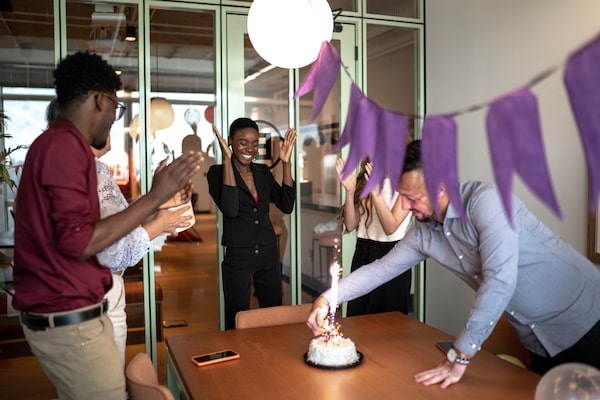
When planning a work event, it’s important to keep in mind that everyone has a different comfort level amid COVID-19.FG Trade/iStockPhoto / Getty Images
Many leaders are looking to rally the team with a workplace event as offices reopen following the pandemic pause.
Taking the time to think through some of the details first will help ensure your return-to-work party is welcoming for everyone invited, says Alicia Jenelle, founder and chief executive officer of Brampton, Ont.-based Alicia Jenelle Events.
“I’m definitely seeing a resurgence in events,” Ms. Jenelle says.
It’s important to keep in mind that everyone has a different comfort level with COVID-19 still in circulation, so those events should remain optional, she suggests.
Many organizations are planning hybrid events, with an in-person gathering for those who feel comfortable and a virtual component for those who aren’t ready yet.
“We know the world is very different this year than it has been, and we want to be respectful of everyone’s personal boundaries,” she says.
Ms. Jenelle suggests organizers do a quick survey of employees before planning begins to gauge their preferences for attending in-person and their needs and preferences. She says it can also be helpful to put together a committee representing a broad swath of the company to be part of the planning.
The summer and early fall are good for combined indoor-outdoor events where attendees have the option of remaining outdoors if they feel more comfortable, she says.
Micro-events are also popular, gathering staff by team or department instead of en masse.
“It does help some people who are a bit hesitant … to have smaller-sized events rather than a company-wide, 400-attendee event,” she says.
She also suggests organizers aim to avoid events tied to specific holidays and focus instead on the season or reason for the gathering.
Also, inspect the venue before booking to ensure it has the required accessibility needs and appropriate signage for necessities such as washrooms. Ms. Jenelle says that most venues will work with a booking organization, and providing your own inclusive signage is relatively easy.
And if you don’t know what’s needed, ask employees, including those with mobility needs or specific requirements, to ensure they’ll be comfortable at the event.
“Have conversations with attendees in advance so that you’re not guessing as much,” Ms. Jenelle says. “Quite frankly, they always appreciate that extra call just to check in.”
One of the most common missteps is not considering those needs early in the planning process, says Devika Pandey, director of learning and knowledge solutions at the Canadian Centre for Diversity and Inclusion.
“The needs of an inclusive event can range from an accessible venue/location, inclusive audio-visual considerations, such as captioning or sign language, to making sure dietary restrictions are considered for refreshments and meals,” Ms. Pandey says.
She agrees that a diverse planning committee is important, as is the venue. Keep in mind whether the location is accessible by public transit and whether the parking or drop-off areas and washrooms are accessible.
And don’t overlook whether presenters have been trained to use inclusive language or whether presentations and materials are provided in an accessible format, she says.
When it comes to speakers, make sure you have diverse representation, and be mindful of religious holidays and time zones before confirming the date and time.
The University of British Columbia (UBC)’s Equity and Inclusion Office has published a thorough checklist for accessible events. The list includes a wide range of considerations, including planning the event at a time that doesn’t exclude working parents or offering child care if possible.
It reminds organizers to place signage and products at a height that can be accessed from a wheelchair or scooter and label food at a buffet so attendees can avoid allergens and follow personal food preferences.
“Assume that there’s going to be a diverse crowd,” says Maï Yasué, interim director of equity, partnerships and engagement at UBC’s Equity and Inclusion Office.
“Signal that you’re trying to make an effort, then people are going to already feel more comfortable to bring things up.”
It’s important to show that you’re considering accessibility and inclusion from the outset, Ms. Yasue adds.
“You don’t want to put the onus on the person trying to come into this space … to wonder, ‘Who do I contact? Are they going to be willing to accommodate my dog or my wheelchair?’ You don’t want them to have to worry about that and wonder whether or not it is going to be an inclusive environment for them.”
Take a universal design approach and create an environment that is broadly comfortable for people of different religions, affiliations and abilities, Ms. Yasue suggests.
She recommends organizers provide relevant documents or information to attendees ahead of the event and follow up with transcripts or videos afterwards.
And consider diversity not just among attendees or presenters but in the planning, such as bringing in local Indigenous catering.
Social gatherings are important events for building social connections and community for a team and can be even more so for team members from under-represented groups, Ms. Yasue says. It’s important to plan gatherings that don’t become another barrier, she adds.
“Creating these social events can be a really important thing right now,” she says.
“I think that was one of the hardest things about COVID. We get work done probably way more effectively and faster than we ever have through this online stuff, but in terms of socializing and building social capital and community, that’s really what’s been lost.”